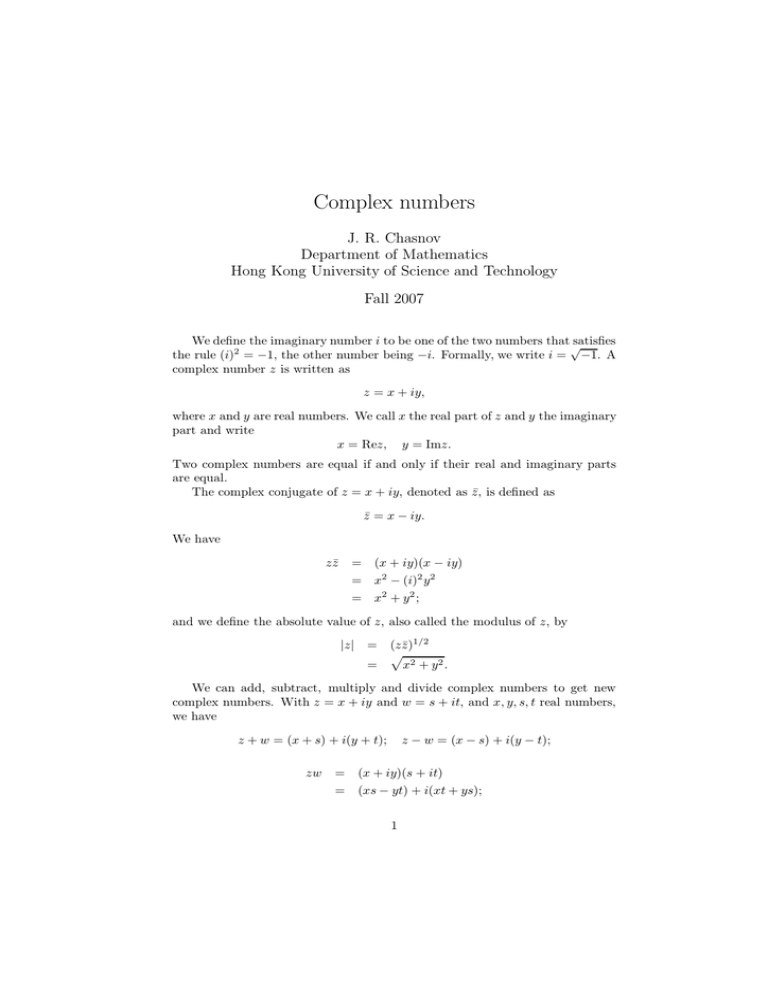Complex numbers - Department of Mathematics
advertisement

Complex numbers J. R. Chasnov Department of Mathematics Hong Kong University of Science and Technology Fall 2007 We define the imaginary number i to be one of the two numbers that√ satisfies the rule (i)2 = −1, the other number being −i. Formally, we write i = −1. A complex number z is written as z = x + iy, where x and y are real numbers. We call x the real part of z and y the imaginary part and write x = Rez, y = Imz. Two complex numbers are equal if and only if their real and imaginary parts are equal. The complex conjugate of z = x + iy, denoted as z̄, is defined as z̄ = x − iy. We have = (x + iy)(x − iy) zz̄ = x2 − (i)2 y2 = x2 + y 2 ; and we define the absolute value of z, also called the modulus of z, by |z| = = (zz̄)1/2 p x2 + y 2 . We can add, subtract, multiply and divide complex numbers to get new complex numbers. With z = x + iy and w = s + it, and x, y, s, t real numbers, we have z + w = (x + s) + i(y + t); zw = = z − w = (x − s) + i(y − t); (x + iy)(s + it) (xs − yt) + i(xt + ys); 1 z w = = = z w̄ w w̄ (x + iy)(s − it) s2 + t2 (xs + yt) (ys − xt) +i 2 . s2 + t2 s + t2 Furthermore, |zw| = = = p (xs − yt)2 + (xt + ys)2 p (x2 + y2 )(s2 + t2 ) |z||w|; and zw = = = (xs − yt) − i(xt + ys) (x − iy)(s − it) z̄ w̄. Similarly z |z| , = w |w| z z̄ ( )= . w w̄ It is especially interesting to consider the exponential function of an imaginary argument. Let f(θ) = eiθ with θ a real number. The function f takes a real number and returns a complex number. We write f(θ) = g(θ) + ih(θ), where g(θ) and h(θ) are real functions. Taking derivatives, and using f ′ (θ) = = = ieiθ if(θ) −h(θ) + ig(θ), we have −h(θ) + ig(θ) = g′ (θ) + ih′ (θ). Equating real and imaginary parts of both sides, we obtain the differential equations g′ (θ) = −h(θ), h′ (θ) = g(θ). We have already met the two functions sin and cos whose derivatives behave in this fashion. Indeed, the only functions that satisfy these two equations are g(θ) = A cos θ, h(θ) = A sin θ, with A any constant. Since f(0) = e0 = 1 = g(0) + ih(0) = A, we find A = 1. Therefore, eiθ = cos θ + i sin θ. 2 Since cos π = −1 and sin π = 0, we derive the celebrated Euler’s identity eiπ + 1 = 0, that links five fundamental numbers: 0, 1, i, e and π using three basic mathematical operations only once: addition, multiplication and exponentiation. The complex number z can be represented in a complex plane with the xaxis being Rez and the y-axis being Imz. This leads to the polar representation of z: z = |z|eiθ . Useful trigonometric relations can be derived using eiθ and properties of the exponential function. The addition law can be derived from ei(x+y) = eix eiy . We have cos(x + y) + i sin(x + y) = (cos x + i sin x)(cos y + i sin y) = (cos x cos y − sin x sin y) + i(sin x cos y + cos x sin y); yielding cos(x + y) = cos x cos y − sin x sin y, sin(x + y) = sin x cos y + cos x sin y. De Moivere’s Theorem derives from einθ = (eiθ )n , yielding the identity cos(nθ) + i sin(nθ) = (cos θ + i sin θ)n . For example, if n = 2, we derive cos 2θ + i sin 2θ = = (cos θ + i sin θ)2 (cos2 θ − sin2 θ) + 2i cos θ sin θ. Therefore, cos 2θ = cos2 θ − sin2 θ, sin 2θ = 2 cos θ sin θ. With a little more manipulation using cos θ + sin2 θ = 1, we can derive cos2 θ = 1 + cos 2θ , 2 2 sin2 θ = 1 − cos 2θ ; 2 which are useful formulas for determining Z Z 1 1 2 cos θdθ = (2θ + sin 2θ), sin2 θdθ = (2θ − sin 2θ), 4 4 from which one obtains the identities Z 2π Z sin2 θdθ = 0 0 3 2π cos2 θdθ = π.



